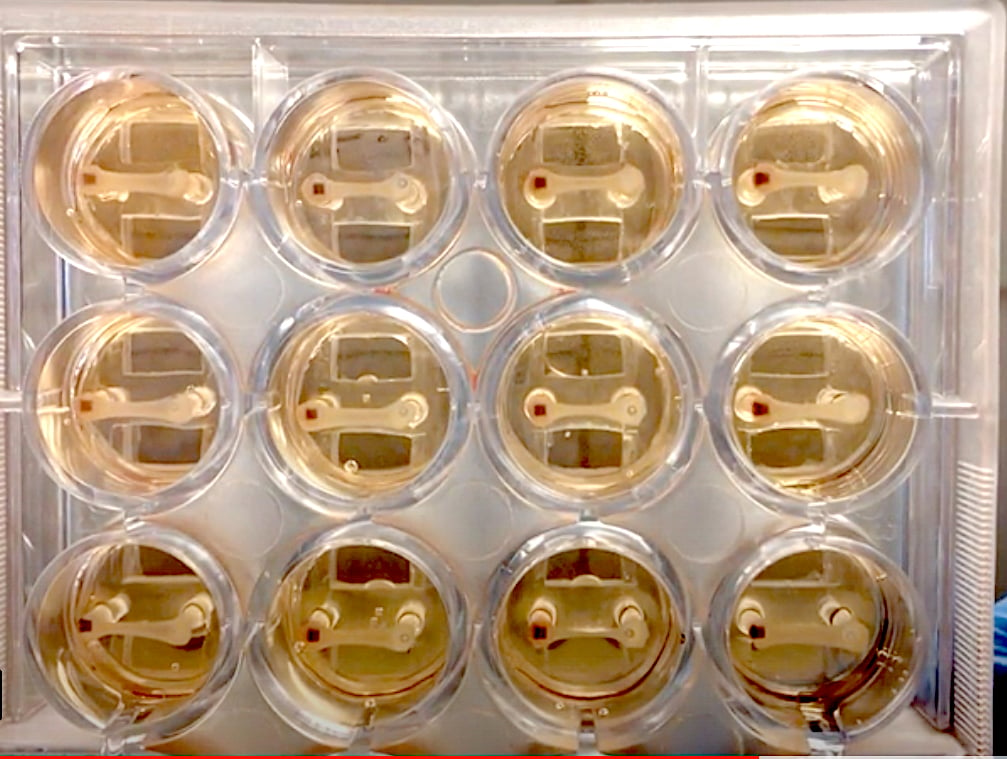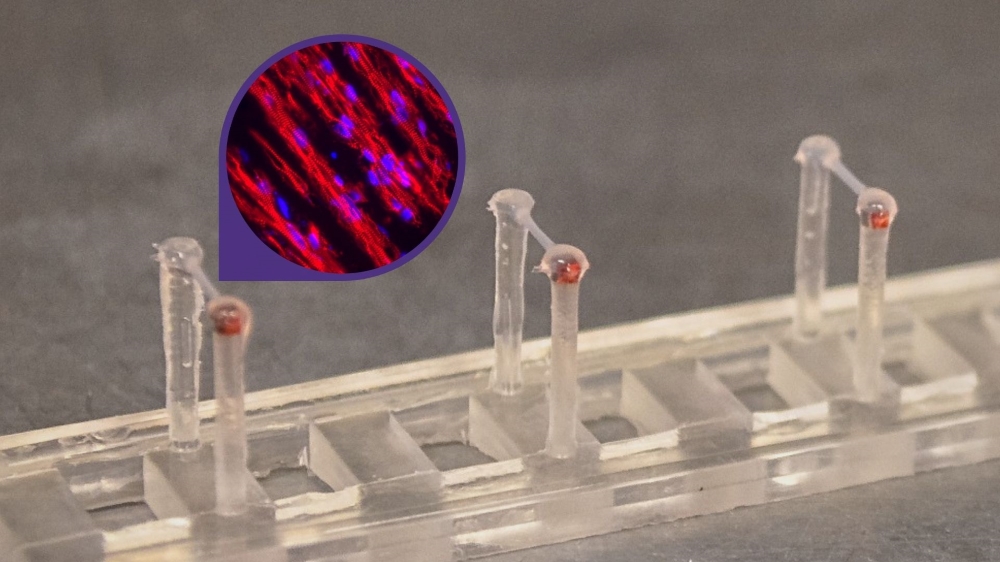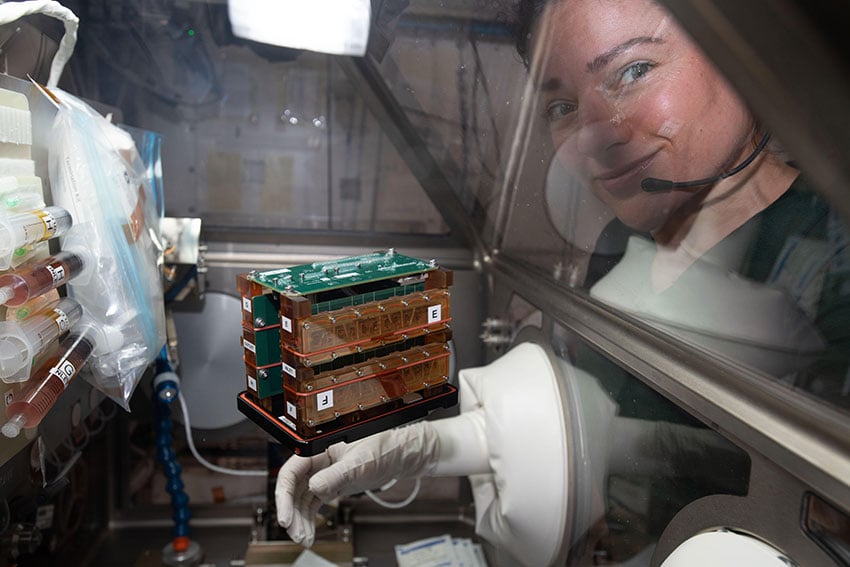
Astronaut Jessica Meir “feeds” a set of the University of Washington’s engineered heart tissues (inside the green-topped case at center) riding aboard the International Space Station as part of a test of micro-gravity on heart health. Image courtesy of NASA.
The University of Washington (UW) in Seattle has developed engineered heart tissue that beats. Though minuscule, the rice-grain sized tissues hold enormous promise for understanding one of the body’s most essential organ. Heart disease is the world’s leading cause of death. The new beating hearts, a sort of heart in a petri dish or organ in a dish, will allow researches to better understand cardiac function under various conditions or test the cardiac impact of new drugs.
Any given week in UW’s Cell Biomechanics Lab researchers might engineer a few dozen of these beating heart tissues. The lab, led by mechanical engineering professor Nathan Sniadecki, is specifically interested in the mechanics of heart tissue – the tightening and stretching of cardiac muscles – and the fundamental relationships between the cellular structures and their functions within the tissue.
“The heart is dynamic - it has an incredible ability to adjust itself,” said Sniadecki, who’s also an associate director for the UW Medicine Institute for Stem Cell and Regenerative Medicine. “Learning more about how and why it makes those adjustments could impact everything from cardiac treatments and drug screening to sports medicine and space travel.”
"Each time I see these beating tissues, I’m still inspired by the awesomeness of our biology. But I also see a world of possibility there for impacting people’s lives, and that’s the most romantic part of all," Sniadecki said.
How to Grow Heart Tissue
The process of engineering a living, beating heart tissue starts with a set of human stem cells that are first urged to develop into cardiac muscle cells. Those cells are carefully and methodically mixed with a cocktail of other cells, proteins and enzymes in a sort of biological Jell-O mold, into which a pair of little pillars is inserted. The pillars are just over a quarter of an inch (8 millimeters) apart.
With the ingredients all in place, the tissues just need time to develop. Within a day the cells start to condense and become fibrous. After about two weeks comes the miraculous moment when the cells start to contract in unison and a heartbeat emerges.

A plate of 12 beating engineered heart tissues. Researchers can measure the strength of each heartbeat using magnets embedded in the pillars they’re suspended from. Photo courtesy of Nate Sniadecki / UW ME
“The first time I saw it, I thought it was the coolest thing I’d ever seen,” said Samantha Bremner, a graduate student in bioengineering who works with Sniadecki in his lab.
Bremner has produced hundreds of these tissues, mastering the small details that ensure each one is consistent enough to use for research.
With the help of tiny magnets embedded in the pillars that the tissues are suspended from, researchers can precisely measure how strong and fast each heartbeat is and monitor the tissue’s condition. If the tissues are healthy and regularly cared for, they can continue beating for months.

A series of miniature engineered heart tissues suspended across pillars about a quarter of an inch apart. Within each tissue is a 3-D assemblage of cardiac muscle fibers (inset). Image courtesy of Nate Sniadecki / UW ME
Cardiac Research Using Engineered Heart Tissue
The engineered tissues are part of a current boom of research that takes advantage of induced pluripotent stem cells – stem cells derived from a Nobel Prize-winning technique where adult skin or blood cells can be reprogrammed into other cell types. In the case of creating heart cells, the research team believes the tissues are useful for a range of new studies of diseases, drugs and medical conditions.
One of the most promising applications of engineered heart tissues is rapidly screening for the potential effectiveness, or side effects, of new drug treatments. Traditionally researchers use lab mice and other small mammals for these kinds of safety tests, but these heart strings offer another way to look for risks that better approximates a human subject. For example, this past year as doctors raced to consider treatments for COVID-19, Sniadecki and colleagues tested giving the novel coronavirus to their engineered tissues and experimented with how different drugs worked against it.
One specific disease that interests Sniadecki and Bremner is Duchenne muscular dystrophy, a genetic condition in which muscles slowly degrade over time because they can not produce a protein called dystrophin. People with this condition are typically in a wheelchair by age 15 and often do not live past their 20s because their hearts give out. The UW research team has created engineered heart tissues using stem cells from people with this condition and observed how the lack of dystrophin damages the muscle fibers.

Astronaut Jessica Meir with the engineered heart tissues in their electronic habitat aboard the International Space Station (ISS). Photo courtesy of NASA
NASA Experiments With Engineered Hearts in Space
There's also a lot to be learned about the how the heart normally functions that can help areas like sports medicine and space travel, said Sniadecki.
Perhaps unsurprisingly, years of training has a significant effect on the size and structure of an athlete’s heart. Heart problems are also the leading cause of death for young athletes, often because of heart conditions they are not yet aware of. Understanding more about the strain that athletes put on their hearts might allow them to train more safely and effectively.
And what about the effects of micro-gravity on the heart? Spaceflight is known to have harmful impacts on the hearts of astronauts, so last year the cell biomechanics Lab, in partnership with colleagues at Johns Hopkins University and the Tissue Chips in Space program, had a chance to observe their tissues in just those conditions, sending them aboard the International Space Station (ISS). Their goal was to try to learn more about what was happens to astronauts’ hearts at a cellular level.
The investigation aboard the ISS in March 2020, looked at how human heart tissue functions in space. It used unique 3-D cardiomyocytes derived from human induced pluripotent dtem cells (hiPSCs), essentially adult stem cells. The engineered heart tissues, or EHTs, are complex 3-D structures, each about the size of a few grains of rice. These structures are more similar to tissues in the body than flat cell cultures in a petri dish or those floating in a flask of liquid.
Researchers expect significant differences in function, structure and gene expression between EHTs in microgravity and those on the ground. Understanding these differences could help them find ways to prevent or mitigate problematic changes on future long-duration space missions.
Read more about the heart on a chip being sent into space in the articles Hearts in Space and NASA's account of the experiment Astronaut Conducts Heart Research on Station with Former Colleague.
“The idea of a ‘gentle heart’ has new meaning to me,” said Ty Higashi, another of Sniadecki’s graduate students, helped lead the effort. “The tissues are incredibly fragile and getting them safely from our lab all the way up to space was definitely a challenge, but I was really happy we pulled it off.”
The little heart cells hung on, surviving the journey to space and, with care from the astronauts aboard, provided heartbeat data for over a month. The team observed a drop in heartbeat force over that time and is analyzing the tissues to look for differences compared to a normal set on Earth.
All these areas represent just a few of the ways the team are hoping their miniature engineered hearts could supply useful new insight.
“The very first stem cell treatment was developed here at UW, so this research really builds on that legacy,” said Sniadecki. “Each time I see these beating tissues, I’m still inspired by the awesomeness of our biology. But I also see a world of possibility there for impacting people’s lives, and that’s the most romantic part of all.”
Related Cardiac Stem Cell Content:
What is New in Cardiology? A Review of All Major Emerging Technologies for Heart Diseases
Three Years After Stem Cell Trial for Heart Failure was Abandoned New Evidence Shows it Works
Stem Cell Therapy Improved Quality of Life in Patients with Microvascular Dysfunction
Placental Stem Cells Can Regenerate the Heart After Heart Attack
How Biotechnology is Impacting the Treatment and Prevention of Heart Disease
Heart Muscle Cells Created From Stem Cells Beat in Sync
FDA Releases Final Guidances on Regenerative Medicine Therapies


 November 12, 2025
November 12, 2025 









